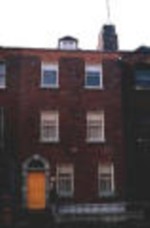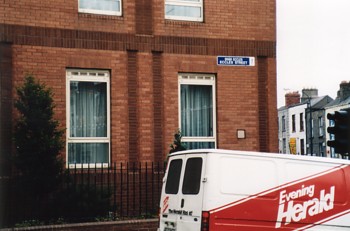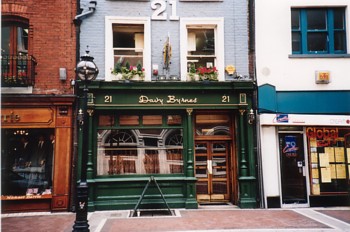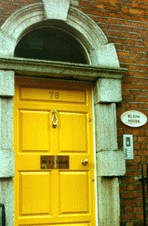|
|
The Literary Traveler
|
an ongoing series by Thomas E. Kennedy and Walter Cummins
|

|
7 ECCLES STREET
by Walter Cummins
We arrived in Dublin for a few days before the flight home after traveling several weeks in the West of Ireland, where Gabriel Conroy, in Joyce's “The Dead,” refused to go, bristling at Miss Ivors' rebuke for his unwillingness to learn of “your own people, and your own country.” Gabriel didn't know what he was missing—the Dingle peninsula, the Burren, Connemara.

|
|
Connemara, the West of Ireland
|
But he wasn't a tourist seeking the fascinations of the landscape. Like his author, he sought European culture, though unlike Joyce he only visited, too timid to exile himself “to forge in the smithy of my soul the uncreated conscience of my race.” Of course, those were the words of Stephen Dedalus, ironically hyperbolic on Joyce's part. Yet, the further irony is that Joyce did plumb the conscience of his race when he wrote Ulysses—the human race, not just the Irish.
To do that, he transformed Dublin into the universal city, the people there—with their dialects, their prejudices, their physical longings, their advertising flyers—into the mythic embodiment of our entire species: a bit foolish, antiheroic, but vital and significant. It's a geographically precise Dublin, vivid in Joyce's exiled memory, verified through queries to people still there and able to check the details.
For example, he wrote a letter asking his aunt
Is it possible for an ordinary person to climb over the area railings of #7 Eccles Street, either from the path or the steps, lower himself down from the lowest part of the railings till his feet are within two feet or three of the ground and drop unhurt? I saw it done myself but by a man of rather athletic build. I require this information in detail in order to determine the wording of a paragraph.
The Blooms, Leopold and Molly, fictional characters, lived in that real house, and the actual rooms are the site of several sections in Ulysses: "Calypso," "Ithaca," and "Penelope." 7 Eccles was in the middle of a row of similar structures, three storeys, plus a lower level with the kitchen. While the novel is set in 1904, from 1908 to 1910 that house was the address of Joyce's friend J.F. Byrne, and Joyce visited him there in 1909, when in Dublin on business.
Of all the places in Dublin, I wanted to see 7 Eccles Street, where Leopold began his day with a grilled mutton kidney and Molly ended hers with 75 unpunctuated stream-of-consciousness pages of erotic affirmation. It was one of the most famous addresses in literature, along with Sherlock Holmes nonexistent 221B Baker Street. But Holmes' digs never had existed. 7 Eccles no longer exists, demolished years after the publication of Ulysses, when Joyce was a pariah in his native land. Today, if it had survived, it would be a shrine, living on in brick and plaster as the Blooms and Stephen and all the others do on the page. Unfortunately, that opportunity is forever lost. But the site itself deserves a visitation. Maybe, I wondered, I might sense an aura, a whiff of kidney.

|
Guided by a street map of the city, we walked from our hotel near the railroad station. The area seemed rather rundown, as did much of Dublin a decade ago, poorer than most European cities, certainly not a slum, just a bit the worse for wear. But as we crossed Dorset Street to reach the corner of Eccles Street, a man in hat and topcoat stopped us in the middle of the pavement and warned my wife to tuck her purse tight under her arm because we were in a dangerous neighborhood. As an American, I was immediately suspicious of him, a blow on the side of the head. Why was he in that neighborhood?
|
|
The Blooms' 7 Eccles Street
|
|
Still, there was something very respectable about him and his pleasant concern. He had probably sensed Joyceans. Perhaps he had made it his life's mission to stand at that intersection and keep them safe, a self-appointed guardian angel.

|
|
The new 7 Eccles Street, now a corner of the Mater Hospital
|
Not to be cheated of a more authentic Joyce experience, we turned west and took a bridge across the Liffy to the more gentrified area of the streets near Trinity College for a meal at Davy Byrnes pub, one of Bloom's many stops on June 16, 1904. The lunch crowd almost nine decades later was much more affluent and subdued but not as colorful at Joyce's embodiments of the locals. Still, being there, amid conflated fact and fiction, felt meaningful, as if I could wonder if Bloom had actually used the same stool that I sat on then.

|
|
Davy Byrnes' pub
|
But across the cobblestones in the entryway of another pub, The Bailey (where Bloom goes first but finds the patrons eating like swine—Circe episode—and leaves in disgust to retreat to the moral pub), stood the actual door, steps, and railings of 7 Eccles Street, the very railings Bloom, his key misplaced, climbed over to give late night access to himself and Stephen Dedalus, the two finally together after all those pages of their separate journeys. It was worth the trip to see the real thing, the presence, the true artifacts.

|
Tom Kennedy tells me "they have redone The Bailey. What used to be a very charming woody old pub has been transformed into a cafeteria of glittery fake-wood and chrome surfaces. It breaks my heart to think of."
The remnants of 7 Eccles Street, door and all, now dwell at the Joyce center on North Great George Street, down in the lower level. Consider it a form of homecoming.
|
|
The door to 7 Eccles Street
|
|
[copyright 2002, Walter Cummins]
|
![]()




